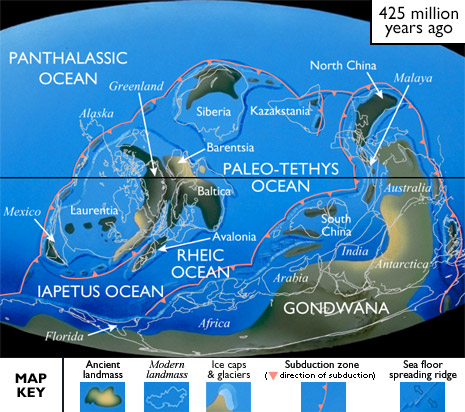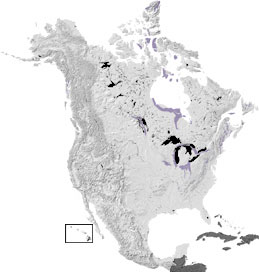the Silurian - 443 to 417 Million Years Ago
|
|
|
World Paleogeography: Continental positions did not change much in the Early Silurian. But, during the Middle and Late Silurian, Siberia moved north, Laurentia headed southeast, and Gondwana continued to stretch from the Equator to the South Pole. Although it remained almost entirely within the southern hemisphere, Gondwana shifted enough to put northern South America over the South Pole instead of Africa. The massive southern hemisphere glaciers that had formed during the Late Ordovician began melting, and Earth’s climate became relatively stable. By the end of the Silurian, the collision between eastern Laurentia and western Baltica closed the northern part of the Iapetus Ocean and resulted in the formation of a huge mountain range. North American Paleogeography: A shallow sea covered much of North America during the Silurian, except for its southern margin (now the East Coast), which was being uplifted. The uplift began as a collision with an island arc in the Ordovician and developed into a collision with the continent of Avalonia by the end of the Silurian. In the shallow sea, limestones, shales, and sandstones were deposited, and many large reefs developed. Paleontology: The Silurian Period was one of the shorter periods of the geologic time scale. Trilobites, brachiopods, crinoids, and bryozoans were abundant in the shallow seas. Within the Silurian rocks, we find the first coral reefs, which were built by now extinct tabulate and rugose corals rather than the familiar stony corals of modern reefs. Fish were important members of the Silurian fauna. Jawless fishes diversified, and the first fish with jaws appeared. We find the earliest good evidence of life on land during the Silurian: tiny vascular plants that grew in moist areas near the shore and along rivers and streams. Centipedes and scorpions were among the first animals to make the transition to land, and we find their rare fossils preserved in Silurian rocks. |
|
 |
See the Silurian in:
Or jump to another period:
|
|
Links to more about the Silurian
|
Collecting and Legalities | Research and Collections | Organizations | Education and Exhibits | Research and Collections | Resources
Collecting and Legalities
Where to Collect Fossils (showing 1 of 1 listings)
Penn Dixie Paleontological and Outdoor Education Center: A natural history center, where visitors can collect their own trilobites. The web page includes information on how to get to the site, fossils which can be found there, and other information.
 Top of List Top of List
Research and Collections
(showing 1 of 1 listings)
The Natural History Museum, London's conodont collection: This database gives broad information about discrete collections within the conodont collection housed at the NHM. Generic, specific and subspecific names are included in the database, but the data is being updated regularly. As a result, the database is best searched by name of donor/collector/publisher or by geological period. Links to images are included with some collections.
 Top of List Top of List
Organizations
Societies and Clubs (showing 1 of 1 listings)
KYANA Geological Society - Louisville, Kentucky: We are a non-profit educational organization, which was founded in 1961, to promote the interests of geology, minerals, fossils, and lapidary arts in Kentucky and Southern Indiana.
 Top of List Top of List
Museums (showing 2 of 2 listings)
Burpee Museum of Natural History: The mission of Burpee Museum of Natural History is to inspire all people to engage in a lifetime of learning about the natural world.
Garvies Point Museum official website: Garvies Point Museum and Preserve is located on Long Island's north shore in New York State. We are a center for regional geology research. Our exhibits deal with regional (Long Island and New York State) geology, fossilization and minerology and the ehnography and archaeology of northeastern Native Americans. Our exhibit "Drifitng Lands and Ancient Seas" details the geology of New York State coordinated with plate tectonics. 
 Top of List Top of List
Education and Exhibits
Virtual Exhibits (showing 3 of 6 listings)
Virtual Museum of Fossils: Geosciences, at Georgia's Valdosta State University, presents an interactive virtual museum of invertebrate and vertebrate fossil specimens. Explore the collection by animal, or by time period from Precambrian to Quaternary. Maps are detailed and include ecosystem distribution. Fossil photographs, many showing multiple views, list information about where the fossil was found, and how it is categorized taxonomically. Some pages feature a drawing of the animal's skeleton showing the fossil bone in red.
The Third Planet - a walk through geologic time: This virtual exhibit offers a tour of the Milwaukee Public Museum's geology exhibits, depicting the continuing evolution of the Earth from the Precambrian to present.
Trilobites of Oklahoma: This site provides a gallery of images of Oklahoma trilobites, with additional classification and locality information. The trilobites are Silurian to Devonian in age.
 More Virtual Exhibits More Virtual Exhibits
 Top of List Top of List
Research and Collections
Researchers (showing 3 of 3 listings)
University of Iowa Paleontology Repository: The UI Paleontology Repository is home to over a million fossils from all over the world and from all time periods, and is used for research and teaching. We also provide education services, hands-on tours around the collections and geology exhibits for schools and community groups, and fossil identification and collection care services.
Dr. Thomas W. Kammer: Specialty: Evolutionary paleoecology of Paleozoic crinoids, plus lithostratigraphy, biostratigraphy, and sequence stratigraphy of marine Mississippian rocks in the east-central United States. Field areas include West Virginia, Kentucky, Indiana, Illinois, Missouri, and Iowa.
Paleobotany and Palynology at the Florida Museum of Natural History: The Paleobotany and Palynology Collection at the Florida Museum of Natural History is international in scope, including collections from 47 countries. Systematically the greatest strength of the collection is in Cretaceous-Tertiary angiosperms.
 Top of List Top of List
Ongoing Research Projects (showing 2 of 2 listings)
Sam Noble Oklahoma Museum of Natural History: On the campus of the University of Oklahoma in Norman. One of the finest university-based museums in the nation, with an active Paleontology research program and extensive collections. 
Vertebrate Paleontology Laboratory, UT: The University of Texas Vertebrate Paleontology Laboratory houses one of the 10 largest collections in North America, and it supports one of the Nation's largest graduate education programs in paleontology. It also supports public exhibits at the Texas Memorial Museum.
 Top of List Top of List
Resources
Image Collections (showing 1 of 1 listings)
Michigan Basin Specimen Database: This site showcases Michigan Basin fossils from the private collections of Friends of the University of Michigan Museum of Paleontology and select specimens from the University of Michigan collection, including type specimens.
 Top of List Top of List
Courses and Lectures (showing 1 of 1 listings)
Paleogeography of the Southwestern U.S.: The paleogeography of the southwestern U.S. from 1.8 billion years ago to 10 million years ago. Text and images by Dr. Ron Blakey from Northern Arizona University.
 Top of List Top of List
Field Guides (showing 1 of 1 listings)
Fossil Cephalopods in Utah: A reference to help provide information on the identity, biostratigraphy and location of fossil cephalopods found in the state of Utah.
 Top of List Top of List
Databases (showing 3 of 4 listings)
New Mexico Museum of Natural History and Science Web-based Paleo-database Home Page: Search the fossil collections of the New Mexico Museum of Natural History and Science. Listings by Kingdom down to species, era, epoch, group, formation, country, New Mexico county, and map ID. Many listings contain images of the fossils (including all holotypes.) 
The Paleointegration Project: The PaleoIntegration Project (PIP) is facilitating interoperability between global-scale fossil and sedimentary rock databases (e.g. The Paleobiology Database and the Paleogeographic Atlas Project), enabling a greater understanding of the life, geography and climate of our planet throughout the Phanerozoic. Databases can be searched via text and interactive maps, and by any combination of age, location, or content. Results can be plotted on present- and paleo- maps or downloaded for detailed analyses.
Fossils in My Back Yard: Explore a geologic map of Iowa, county by county, to see lists and photos of fossils in the collections of the University of Iowa Paleontology Repository.
 More Databases More Databases
 Top of List Top of List
Annotated Bibliographies (showing 1 of 1 listings)
Bibliography of Paleobotany: A bibliographic database of paleobotany including more than 56,000 entries. It also includes references on Antarctic geology and paleontology and citations on Women in Science.
 Top of List Top of List
Maps (showing 1 of 1 listings)
Paleogeography and Geologic Evolution of North America: The images presented here show the paleogeography of North America over the last 550 million years of geologic history.
 Top of List Top of List
General Reference (showing 2 of 2 listings)
Fossils In Death Valley National Park: The paleontology, geology and natural wonders of Death Valley National Park (and more); many images of fossils; field trips; paleontology links, plus links to Death Valley.
List of Dinosaurs: This dinosaur listing is data-packed and can be sorted by dinosaur length, weight, time period, etc.
 Top of List Top of List
|
|



